By Rock Island Auction
On January 23, 1873 an order was placed by the U.S. Government to Colt Manufacturing for 8,000 revolvers “of the new model.” The first 1,000 would only take Colt 41 days to complete. Before a single example could leave the factory they would of course need to be inspected. Enter one Orville W. Ainsworth, the civilian “Principle Sub-Inspector” for the Ordnance Office of the War Department. Ainsworth would perform the physical inspections of revolvers numbered #202 – 14,343. He took ill before he could finish inspecting the subsequent contract renewal, but his stamp was still used until that renewal was finished. According to A Study of the Colt Single Action Army Revolver that the actual dates of service for Ainsworth (and not his stamp) were from mid-October 1873 until November 7, 1874. There are two major reasons why any of this matters . . .
1. This limited use of Ainsworth’s “A” inspector stamp makes revolvers bearing them rare, collectable, and valuable items.
2. It was these two large orders of arms that supplied much of the U.S. Cavalry and therefore they saw heavy use in the Indian Wars, including the Battle of Little Big Horn.
When the aforementioned book—an essential resource for Colt SAA Collectors—was printed in 1976, only 375 of the original 12,500 Ainsworth inspected revolvers were known to exist in collections; a humbling 3% of the total. As of the 1994 printing of Kopec and Fenn’s Cavalry & Artillery Revolvers: A Continuing Study, that number had shot to 1,655 or 13.2%. One can only hope the number has improved in the near ten years since that book was published.
Of these 1,655 known Ainsworth inspected revolvers only 16 are known to be stamped on their frame with the text, “CO. K. 4. CAV.” When latter of the two books mentioned was published in 1994, there were only 15 known to exist. The example that will be sold in Rock Island Auction Company’s 2013 December Premiere Auction, serial number 3576, is the 16th. The known serial number range spans from 2902 – 4596. This range has perplexed Colt scholars for years, for the following reason: all of the Company K, 4th Cavalry revolvers were ordered on January 15th, 1874 and shipped to the San Antonio Arsenal.
Thanks to letters sent at the time, we know that the 6th and 10th Cavalries were each to receive 1,000 of the “new Colt’s revolver.” But that “upon recommendation of the General of the Army, the Secretary of War designates the 4th Cavalry, as the next regiment to receive the Carbines and Revolvers of the new model.” A note on that letter states that the arms to be shipped to the San Antonio Arsenal for the 4th Cavalry, but the specific number shipped is not mentioned.
One can assume that a shipment of 1,000 (1,000 per Regiment) was shipped to San Antonio that January. So while existing historic documents would imply that 1,000 items were shipped to San Antonio, the known serial number range spans over 1,700. Were all 2,000 revolvers diverted to San Antonio? Have enough not been uncovered to show us the full serial range? Were the serial numbers sent simply non-sequential? Furthermore, if there were so many, where are the remaining examples? These are all questions that persist regarding these coveted revolvers.
Some credence is given to the “non-sequential” theory by another firearm present in this auction. In lot #1181 is what our headline describes as a “Rare Second Year Production Ainsworth Sub-Inspected Colt Single Action Army Cavalry Revolver with Period Holster.” It has all the early production features, the “A” sub-inspection stamp of Ainsworth, and most importantly, a serial number of 3316. This serial number puts it in the same serial range as the CO. K. 4. CAV revolvers, yet it lacks that rare and desirable marking.
Lot 1181: Rare Second Year Production Ainsworth Sub-Inspected Colt Single Action Army Revolver with Period Holster. While not marked to a designated unit on its frame, this unaltered, Ainsworth stamped Colt, which falls in the Company K, 4th Cavalry serial range, is still expected to sell for between $10,000 – $20,000.
History of Co. K. of the 4th Cavalry
In 1848, after the Mexican War, the U.S. Army slowly came to realize that it needed additional mounted soldiers as the young country spread Westward. The 4th Cavalry Regiment has its origins in the year 1855, when it was known as the 1st Cavalry, having been formed to alleviate the government’s self-assessed lack of horse borne troops. However, on August 3, 1861 all cavalries were to be renumbered according to seniority. Having been preceded in formation by the 1st Dragoons, 2nd Dragoons, and the “Regiment of Mounted Rifleman,” the 1st Cavalry was re-designated as the 4th Cavalry Regiment.
Immediately after their formation, they spent a great deal of time in Fort Leavenworth, Kansas to help protect settlers from Cheyenne Indians and to help quell any disturbances that would arise from a population heavily divided on the issue of slavery. This newly-formed group possessed the seeds of greatness by having 22 of its 28 officers become general officers serving on both sides of the Civil War including such historic names as Maj. Gen. George B McClellan and Maj. Gen. J.E.B. Stuart. In fact, then Colonel Robert E. Lee commanded the 1st Cavalry for a month before resigning to join the Confederacy.
Prior to the Civil War the 1st Cavalry found themselves split-up with half at Fort Riley, Kansas and the rest spread around the state. During the Civil War, the newly-renamed 4th Cavalry found itself in places stretching from the mighty Mississippi River to the Atlantic Ocean. The earliest Civil War mention (that could be found by this writer) of Company K of the 4th Cavalry is on May 9-14, 1862 where the action of Co. K, as well as Companies B, C, D, G, I, & K, were “present at Corinth, Miss . . . a detachment under Lieut. Gordon took part in an affair near Farmington, Miss.: no casualties.”
The second earliest mention of Company K occurs at Murfreesboro, TN, during the Stone River campaign (1862-1863) on December 31 1862, when a two-company brigade of the 4th U.S. Cavalry charged “an entire brigade of cavalry and routed them to such an extent that they disappeared from the field altogether.” Company K also saw action at Middleton, TN (May 20-23, 1863), and Okalong, MS in February of 1864. After the Civil War, Co. K. of the 4th Cav is most noted for its campaigns against the Comanche and Kiowa during the early 1870s under Col. Ranald Slidell “Bad Hand” Mackenzie, one of the seven colonels honored by the 4th for their distinction in service. Mackenzie’s fascinating history, stretching from the Battle of Second Bull Run and well into the Indian Wars, is vast, heroic, and documented enough that it could easily fill its own column.
The 4th Cavalry in 1909
Condition
The condition of this revolver cannot be overstated. The amount of finish is unprecedented and the mature case-hardening provides it a striking ghostly grayed contrast. Lest one think that we are biased in our enthusiasm for this firearm, here are two evaluations from noted industry experts.
“Regarding Subject Revolver; Colt Single Action Army, serial # 3576. In my opinion, This revolver is the finest Ainsworth inspected, U.S. Army marked, Single Action known to exist. It was my pleasure to examine it…”
A letter dated July 6, 1998 from
Ronald A Ogan, President
Ogan Antiques, Ltd.
“Considering the low survival rate of early US-marked Single Action Army revolvers and considering the exciting and important times in which these revolvers were used, this scare and desirable Colt is an object of considerable significance. The author will be pleased to illustrate number 3376 in the forthcoming revised edition of THE BOOK OF COLT FIREARMS, which will be issued in a two-volume book.
In condition and originality, no revolver equals, or surpasses, number 3376. The color of the blue, the patina of the steel and wood, the old grease from years’ past, and the clouded color the case-hardening (excepting on the relatively bright hammer) are all indicative of the attic-condition, unused survival of this remarkable and rare Single Action Army Colt revolver.”
– R. L. Wilson
Author and Expert
The fact that this gun came to light after so many years of only having 15 examples, in addition to its remarkable condition must have made quite a stir in the Colt collecting community. Its existence alone would be a noteworthy find, but its “finest known” quality truly makes it a special story.
A rarity within a rarity that also possesses a fascinating history and some persistent, unanswered questions that have stumped Colt scholars for decades, the Ainsworth inspected, Co. K 4 CAV Colt Cavalry Model revolver is a simply fantastic piece that Rock Island Auction Company is proud to have in its 2013 December Premiere Auction. The 4th Cavalry has served this country since before the Civil War and continues to serve through the current wars in the Middle East. Their history of brilliant and illustrious service is forever noted in the annals of U.S. history and even earned them their own march in 1926 written by the “March King,” John Phillip Sousa, himself a dedicated horseman.
That history, combined with an exquisite condition, make this a revolver that will have Colt collectors’ hearts racing. This is one example of the over 600 Colts available in our December 2013 Premiere Firearms Auction, which will contain everything from a near-pristine Colt Model 1851 Navy to a Model 1874 Gatling gun, and SIX different Paterson revolvers! Click here to search our catalog or use one of our previously created Colt categories such as 1st Generation Single Action Army or Colt – Auto Early.
SOURCES:
Graham, Ron, John A. Kopec, and C. Kenneth Moore. A Study of the Colt Single Action Army Revolver. S.l.: S.n., 1976. Print.
Kopec, John A., and H. Sterling. Fenn. Colt Cavalry & Artillery Revolvers: A Continuing Study. 1st ed. Vol. 2nd. Whitmore, CA: J.A. Kopec Publications, 1994. Print.
http://www.25thida.org/4thcav.html
http://www.history.army.mil/books/R&H/R&H-4CV.htm

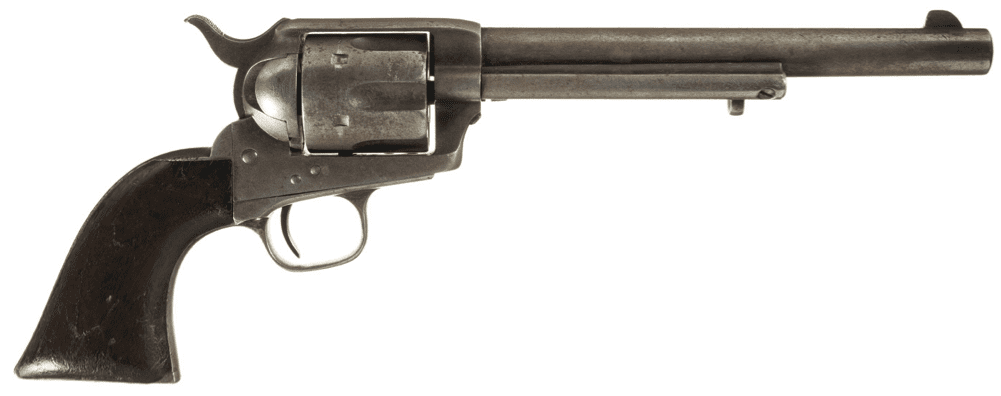
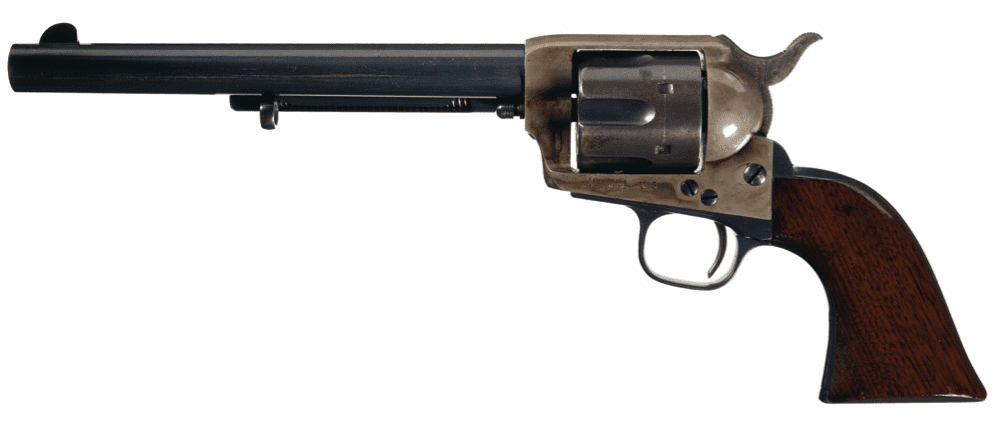
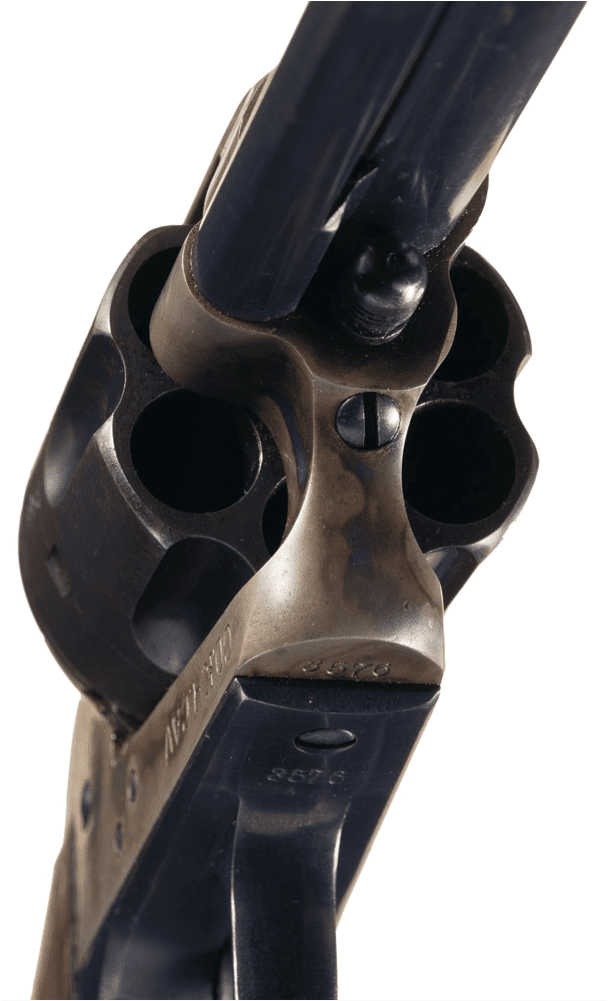

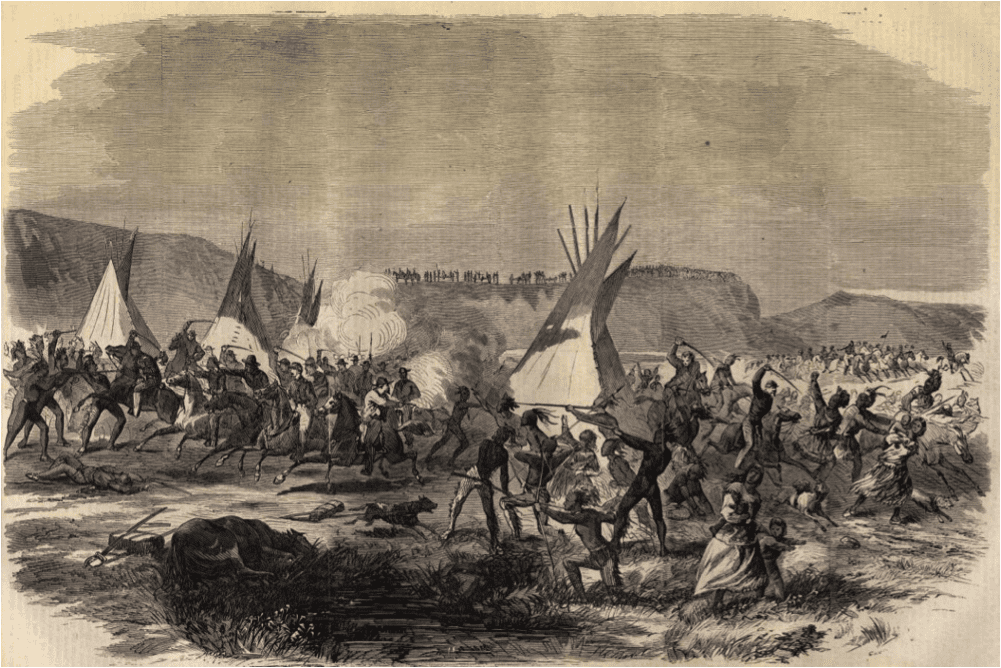

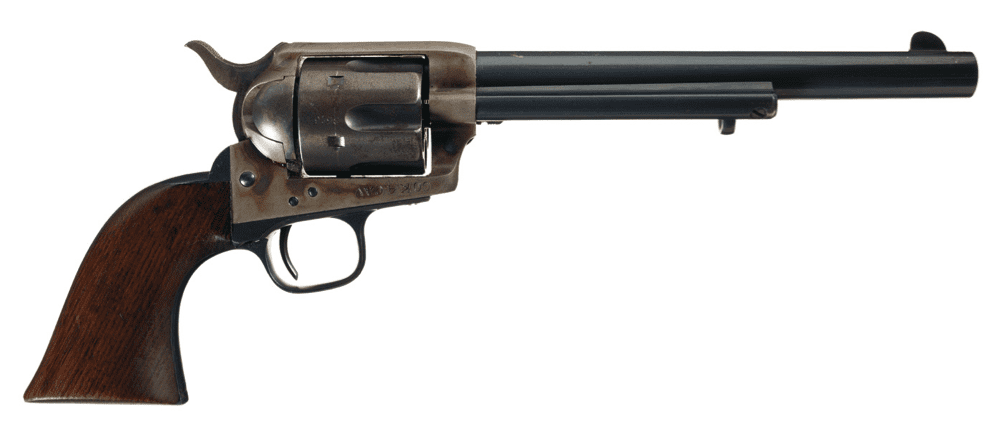



Love these kinds of posts.
Much better than the latest blah-blah from Shannon Watts or Hizzonor.
But one question remains to be adressed and answered. Will it blend?
I am prepared to be crucified…
Ah, one of the oldies that is on my wish list, Colt SAA…stupid Revolver Ocelot made me want this and now TTAG has reminded me of it.
that finish looks like it held up better than some of mine from the 1980s.
An SAA is on my short list. This piece is stunning, and far beyond my wildest dreams. Why is it, though, that Colt can’t seem to make a revolver where the cylinder lock doesn’t drag and score the cylinder?
They did. Both the 1876 LIghtning/Thunderer series and the 1878 Frontier double-action had no stop slots on the surface of the cylinder, and no stop bolt in the bottom of the frame. The cylinders were smooth except for the lightening grooves. Each had cylinder hands that doubled as the cylinder stop by using an extra ‘step’ on the hand, and each locked at the rear of the cylinder at the ratchets. Thus, no drag marks. Pretty neat trick for 1876, except that they got sloppy very quickly.
I’d love a Colt SAA, but the price is just not right. I’ll have to “settle” with my Colt M1917 which has been a lot of fun to shoot.
I’ve been getting into Ruger Blackhawks lately (I have a collection of one so far). I don’t think I’ll be writing any $20,000 checks in the near future, so they’re the next best thing. There are a lot of collectables available if you check out the auction sites. High end guns for modest prices IMHO.
If these guns could talk……
What a stunning example. Attic find indeed. In a dry climate. Just wow.
I couldn’t own something like this. I’d be at the range within 24 hours of receiving it, and getting it dirty.
Doubtless a fake.
Now you’re talking,these are just up my ally,I own ten single actions and three Colt 44 Opentops, which date from1871-2 .
Larry Wilson is a good friend of mine and lives about two miles away.I have almost all his books and if you want an education on old colts,get his books you won’t regret it!
Rock Island’s catalogue s are the best and you should get on their list
I owned the lowest serial numbered Company K Colt, #2293, verified by Kopec. This Colt is no fake, but the condition and finish of the K colts is not original to the period of production, but to the period in 1896 when K company was assigned to the Presidio in San Francisco. It’s duty was to patrol Sequoia national park. Carbines were forbidden, and the Calvary was to be a strack unit presenting a polished vision to the tourist. To wit, their guns were refinished by Springfield armory and then stamped with the CO K 4 CAV logo. This is obvious due to the type and texture of the case color, identical to Springfield work, and the excessive polish in some areas, along with the flattening of all the Ainsworth proof marks. Original finish guns will have the A stamping proud in the metal, the edges sticking up from the surface. This is not evident on the K company guns indicating refinish. Sorry Larry Wilson, just the way it is.
Comments are closed.